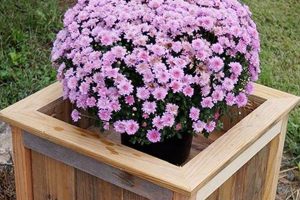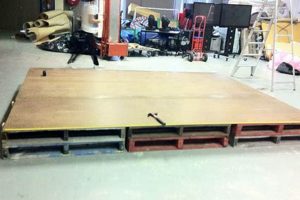A self-constructed workspace made primarily of timber constitutes a personalized and often cost-effective furniture solution. These pieces, typically assembled from readily available lumber and hardware, offer a tangible alternative to commercially produced furniture. Examples range from simple, repurposed tabletops affixed to prefabricated legs, to complex, custom-designed structures incorporating drawers, shelving, and integrated cable management systems.
The appeal lies in the potential for significant cost savings compared to purchasing a pre-made equivalent and in the enhanced personalization. Individuals can tailor dimensions, materials, and aesthetic details to perfectly suit their specific needs and workspace constraints. Historically, crafting one’s own furniture represents a return to traditional skills and a rejection of mass-produced items, promoting sustainability and a connection to the creation process.
The subsequent sections will delve into essential aspects such as selecting appropriate materials, outlining necessary tools and techniques, providing detailed construction guidance, and exploring various design options to facilitate the successful completion of a personalized workspace.
Essential Considerations for a Timber Workspace Project
The creation of a self-made timber workspace demands careful planning and execution. The following guidance aims to minimize errors and maximize the functional and aesthetic value of the finished product.
Tip 1: Precise Measurement is Critical: Prior to any cutting or assembly, meticulously measure the intended space and the desired dimensions of the workspace. Account for any potential obstructions or ergonomic considerations.
Tip 2: Material Selection Impacts Durability: Choose timber based on its strength, stability, and aesthetic qualities. Hardwoods like oak or maple offer superior durability compared to softwoods like pine, but may require more specialized tools for working.
Tip 3: Safety Equipment is Non-Negotiable: Always wear appropriate safety glasses, hearing protection, and dust masks when operating power tools. Secure the workpiece firmly to prevent movement during cutting or shaping.
Tip 4: Pre-Drilling Prevents Splitting: When driving screws, pre-drill pilot holes slightly smaller than the screw diameter. This prevents the wood from splitting, ensuring a stronger and more aesthetically pleasing joint.
Tip 5: Sanding Ensures a Smooth Finish: Thoroughly sand all surfaces before applying any finish. Start with a coarse grit sandpaper and gradually progress to finer grits to achieve a smooth and even surface.
Tip 6: Finishing Protects and Enhances: Apply a protective finish, such as varnish, polyurethane, or oil, to protect the timber from moisture, scratches, and UV damage. Choose a finish that complements the wood’s natural color and grain.
Tip 7: Cable Management Promotes Organization: Integrate cable management solutions into the workspace design. This could include grommets, channels, or trays to keep wires organized and out of sight.
Adhering to these recommendations will significantly enhance the quality and longevity of the self-constructed workspace. Meticulous planning and careful execution are essential for achieving a functional and visually appealing result.
The following sections will provide detailed instructions on specific design choices and advanced construction techniques.
1. Material Selection
Material selection is a foundational element in the creation of a self-constructed timber workspace. The choice of wood dictates structural integrity, aesthetic qualities, and the overall longevity of the finished piece. A thorough understanding of various timber options is, therefore, essential for a successful project.
- Hardwood vs. Softwood
Hardwoods, such as oak, maple, and walnut, provide superior strength and resistance to dents and scratches, making them ideal for work surfaces subjected to heavy use. However, hardwoods typically command a higher price point and may require specialized tools for cutting and shaping. Softwoods, including pine, fir, and cedar, offer a more cost-effective alternative and are generally easier to work with. However, softwoods are more susceptible to damage and may require additional protective finishes to ensure durability.
- Dimensional Stability
Dimensional stability refers to a wood’s ability to resist changes in size and shape due to variations in humidity and temperature. Wood with high dimensional stability is less likely to warp, crack, or swell over time. Species like mahogany and teak are known for their excellent dimensional stability, but may not be readily available or cost-effective for all projects. Proper sealing and finishing techniques can also mitigate the effects of environmental changes on less stable woods.
- Grain Pattern and Aesthetics
The grain pattern and color of the wood significantly impact the aesthetic appeal of the workspace. Different wood species exhibit distinct grain patterns, ranging from the straight, uniform grain of pine to the intricate, swirling grain of walnut. The choice of wood should align with the desired aesthetic, whether it be a rustic, natural look or a more refined, contemporary style. Stain and finish options can further enhance or alter the natural color and grain of the wood.
- Sustainability and Ethical Sourcing
The environmental impact of timber harvesting is an important consideration. Choosing sustainably sourced wood, certified by organizations like the Forest Stewardship Council (FSC), ensures that the wood comes from responsibly managed forests. Reclaimed or repurposed wood offers an even more sustainable alternative, reducing the demand for newly harvested timber and adding a unique character to the workspace.
The careful selection of materials directly correlates with the performance and visual appeal of the completed timber workspace. By considering factors such as wood type, stability, grain, and sustainability, one can create a durable, aesthetically pleasing, and environmentally conscious piece of furniture that meets individual needs and preferences. Alternative materials, like reclaimed wood or butcher block, offer unique aesthetics and functionalities within the same considerations.
2. Structural Integrity
Structural integrity is paramount in the construction of a self-made timber workspace. The ability of the workspace to withstand anticipated loads and stresses directly impacts its functionality, safety, and longevity. Careful consideration must be given to design, materials, and construction techniques to ensure a stable and durable structure.
- Joinery Methods
The selection and execution of joinery methods are fundamental to structural integrity. Dovetail joints, mortise and tenon joints, and lap joints provide robust connections that distribute stress effectively. The choice of joint depends on the specific application and the forces it will endure. Inadequate joinery can lead to premature failure, instability, and potential hazards.
- Load Bearing Capacity
Determining the anticipated load-bearing capacity is crucial. Consider the weight of equipment, materials, and any other items that will be placed on the workspace. The design must incorporate sufficient support and reinforcement to prevent sagging or collapse. Calculations should account for both static and dynamic loads, ensuring the structure can withstand sudden impacts or shifts in weight distribution.
- Material Properties and Deflection
The mechanical properties of the chosen timber directly influence structural performance. Factors such as modulus of elasticity, bending strength, and shear strength determine the wood’s resistance to deformation under load. Excessive deflection, or bending, can compromise stability and lead to eventual failure. Reinforcement techniques, such as adding aprons or stiffeners, can mitigate deflection and enhance overall strength.
- Stability and Bracing
Lateral stability is essential to prevent racking or twisting of the workspace frame. Incorporating diagonal bracing, shear panels, or solid back panels provides resistance to lateral forces. These elements enhance the overall rigidity of the structure and minimize the risk of collapse due to side-to-side movement.
Achieving structural integrity in a timber workspace requires a holistic approach. Meticulous planning, careful material selection, precise joinery, and appropriate bracing are all essential elements. A well-engineered structure ensures a safe, functional, and enduring workspace that can withstand the demands of daily use.
3. Ergonomic Design
Ergonomic design principles are intrinsically linked to the successful creation of a self-constructed timber workspace. Failure to integrate these principles can result in physical discomfort, reduced productivity, and potential long-term health issues. The dimensions of the worksurface, the placement of peripherals, and the overall posture it encourages are all directly influenced by ergonomic considerations. A poorly designed workspace can lead to musculoskeletal disorders, eye strain, and chronic pain, thereby negating the intended benefits of a personalized work area. Consider, for example, a workspace with an improperly elevated surface. This compels the user to hunch over, placing undue stress on the neck and back. Conversely, a surface that is too high can lead to shoulder and arm fatigue. Both scenarios demonstrate the direct cause-and-effect relationship between ergonomic design and physical well-being within the context of a workspace.
The implementation of ergonomic principles in self-made workspaces translates to practical design choices. Adjustable-height options allow the user to alternate between sitting and standing positions, promoting circulation and reducing sedentary behavior. The incorporation of keyboard trays positions the hands and wrists at a neutral angle, mitigating the risk of carpal tunnel syndrome. The strategic placement of monitors at eye level minimizes neck strain. Real-world examples demonstrate the significance of these choices. A data analyst who spends hours analyzing spreadsheets benefits from a workspace that accommodates multiple monitors at the correct viewing distance and height. An architect requires a large, uncluttered surface with adjustable lighting to reduce eye strain during detail work. These scenarios underscore the importance of tailoring the workspace to the specific demands of the user’s activities.
In summary, ergonomic design is not merely an aesthetic consideration but a fundamental component of a functional and healthy workspace. By prioritizing posture, minimizing strain, and adapting to individual needs, a self-constructed timber workspace can provide a comfortable and productive environment. Challenges in implementing these principles may arise from space constraints, budget limitations, or a lack of familiarity with ergonomic best practices. However, resources are available to guide individuals through the process, ensuring that the final product promotes well-being and enhances overall work performance. Prioritizing these components, the final product promotes well-being and enhances overall work performance.
4. Surface Finishing
Surface finishing represents a crucial stage in the creation of a self-made timber workspace, significantly influencing the durability, aesthetics, and user experience of the final product. It acts as a protective barrier against moisture, scratches, and ultraviolet (UV) radiation, thereby extending the lifespan of the timber. The choice of finish and application method directly impacts the look and feel of the worksurface, transforming raw wood into a refined and functional element. Without adequate surface finishing, a self-constructed timber workspace remains vulnerable to environmental damage and premature wear, potentially negating the benefits of custom design and construction.
Practical examples illustrate the importance of informed surface finishing decisions. A workspace intended for crafting or art projects requires a durable, chemical-resistant finish to withstand spills and stains. Options include polyurethane or epoxy resin coatings, which provide a robust and easily cleanable surface. Conversely, a workspace used primarily for computer work may benefit from a natural oil finish that enhances the wood grain and provides a softer, more tactile feel. Proper preparation, including sanding and cleaning, is essential for achieving a smooth and even finish. Failure to adequately prepare the surface can result in blemishes, uneven color, and reduced adhesion of the finish.
In conclusion, surface finishing is an indispensable component of a successful timber workspace project. It serves both protective and aesthetic functions, enhancing the wood’s natural beauty while safeguarding it from environmental factors. The selection of appropriate finishing materials and the application of proper techniques are critical for achieving a durable, aesthetically pleasing, and user-friendly worksurface. Challenges may include selecting the appropriate finish for the intended use and mastering the application process to avoid imperfections. However, the investment in time and effort results in a finished product that is both functional and visually appealing, maximizing the value and longevity of the self-made workspace.
5. Cable Management
The integration of cable management solutions is a critical consideration in the design and construction of a self-made timber workspace. Effective organization of cables and wires not only enhances the aesthetic appeal of the finished product but also promotes safety, accessibility, and long-term functionality.
- Aesthetics and Workspace Organization
Unmanaged cables create visual clutter, detracting from the clean lines and natural beauty of a timber desk. Implementing strategies such as cable trays, sleeves, and concealed routing systems minimizes visible wiring, contributing to a more organized and professional workspace. This improves overall productivity and reduces distractions.
- Safety and Hazard Prevention
Loose cables pose a significant tripping hazard and can create a risk of electrical shock or fire. Securing and routing cables effectively reduces the likelihood of accidents and ensures a safer working environment. Proper cable management is particularly important in workspaces with multiple electronic devices and power sources.
- Accessibility and Maintenance
Well-organized cables facilitate easier access for maintenance, troubleshooting, and equipment upgrades. Clearly labeled cables and strategically placed access points allow for quick identification and replacement of faulty components without disrupting the entire system. This reduces downtime and simplifies routine maintenance tasks.
- Ergonomics and User Comfort
Poorly managed cables can interfere with ergonomics, restricting movement and creating uncomfortable working conditions. Ensuring that cables are routed away from areas where they could snag or impede movement promotes a more comfortable and efficient workspace. Strategic cable placement also prevents cables from becoming entangled or damaged, extending their lifespan.
The strategic implementation of cable management solutions is an integral component of a well-designed and functional timber workspace. By prioritizing organization, safety, accessibility, and ergonomics, individuals can create a more productive and aesthetically pleasing work environment. The integration of these features directly impacts the long-term value and usability of the self-made timber desk.
6. Aesthetic Appeal
The aesthetic appeal of a self-constructed timber workspace is a significant factor influencing its overall value and the user’s satisfaction. Beyond mere functionality, the visual characteristics of the workspace contribute to a positive work environment, enhancing productivity and creativity. Achieving a desired aesthetic requires careful consideration of various design elements and their interplay.
- Wood Species and Grain Pattern
The selection of wood species directly determines the visual texture and color palette of the workspace. Each wood type exhibits a unique grain pattern, ranging from the straight lines of pine to the complex swirls of walnut. The natural color variations within the wood further contribute to the aesthetic. The choice of wood should align with the desired style, whether rustic, modern, or traditional. For example, reclaimed wood can offer a weathered, vintage aesthetic, while a smooth, light-colored maple can create a minimalist, contemporary feel.
- Finish and Color Tone
The chosen finish significantly alters the appearance of the wood, influencing its sheen, color saturation, and overall tone. A clear finish accentuates the natural grain and color of the wood, while stains can darken or lighten the wood, introducing a wider range of color options. The level of gloss, ranging from matte to high-gloss, impacts the reflectivity of the surface and its visual impact. The finish should be selected to complement the surrounding decor and the user’s personal preferences. For example, a dark walnut stain with a matte finish can create a sophisticated and understated look.
- Form and Proportion
The shape and dimensions of the workspace contribute to its overall visual balance and appeal. The proportions of the tabletop, legs, and any incorporated storage elements should be carefully considered to create a harmonious and aesthetically pleasing design. Asymmetrical designs can introduce visual interest, while symmetrical designs convey a sense of order and stability. The size of the workspace should be appropriate for the available space and the user’s activities. For instance, a large, expansive workspace can convey a sense of power and creativity, while a smaller, more compact workspace can foster a sense of focus and efficiency.
- Hardware and Detailing
The selection of hardware, such as drawer pulls, hinges, and leg attachments, can significantly impact the aesthetic appeal of the workspace. The style, material, and finish of the hardware should complement the overall design. Simple, minimalist hardware can create a clean and modern look, while ornate, decorative hardware can add a touch of elegance and sophistication. The attention to small details, such as the shaping of edges and the smoothness of surfaces, further enhances the aesthetic quality of the workspace. For example, brushed metal hardware can create a sleek and contemporary aesthetic, while antique brass hardware can evoke a sense of history and craftsmanship.
In summary, the aesthetic appeal of a self-made timber workspace is a product of thoughtful design choices, careful material selection, and meticulous craftsmanship. By considering the interplay of wood species, finish, form, and hardware, individuals can create a workspace that is not only functional but also visually pleasing, contributing to a more positive and productive work environment. The aesthetic considerations are often intertwined with functional requirements, leading to a personalized and unique workspace design.
7. Workspace Integration
Workspace integration, in the context of a self-constructed timber desk, refers to the alignment of the desk’s design and functionality with the specific needs and environment of its intended use. It transcends mere physical presence, encompassing a holistic approach that considers spatial constraints, technological requirements, and ergonomic principles to optimize the user’s workflow and experience.
- Spatial Optimization
Spatial optimization involves adapting the dimensions and configuration of the desk to the available space. In small rooms, a corner desk or a wall-mounted unit may be more suitable, maximizing usable area. Conversely, larger spaces may accommodate expansive workstations with integrated storage solutions. Practical examples include designing a narrow desk for a hallway workspace or incorporating shelving units above a desk to compensate for limited floor space.
- Technological Accommodation
Technological accommodation addresses the integration of computing devices, peripherals, and power sources. This facet includes cable management solutions, monitor placement, and the incorporation of docking stations or charging ports. Consider a graphic designer’s workstation, which requires ample surface area for a drawing tablet and multiple monitors, along with strategically positioned power outlets. Neglecting these elements can lead to a cluttered and inefficient workspace.
- Ergonomic Alignment
Ergonomic alignment focuses on optimizing the desk’s dimensions and features to promote proper posture and reduce physical strain. Adjustable height mechanisms, keyboard trays, and monitor stands are examples of ergonomic considerations. A desk designed for prolonged sitting should incorporate adjustable features to accommodate individual user preferences and prevent musculoskeletal issues. Without proper ergonomic alignment, a custom-built desk may inadvertently contribute to discomfort and reduced productivity.
- Aesthetic Harmony
Aesthetic harmony emphasizes the integration of the desk’s design with the existing dcor and style of the room. This involves selecting materials, finishes, and design elements that complement the surrounding environment. A rustic timber desk may be well-suited for a home office with exposed brick, while a sleek, minimalist desk may be more appropriate for a modern, contemporary setting. Ignoring aesthetic harmony can result in a discordant and visually unappealing workspace.
These facets of workspace integration underscore the importance of considering the broader context when designing and constructing a self-made timber desk. A desk that is perfectly tailored to its intended use and environment will offer enhanced functionality, comfort, and aesthetic value. In contrast, a poorly integrated desk may detract from the overall quality of the workspace and fail to meet the user’s specific needs.
Frequently Asked Questions
This section addresses common inquiries regarding the planning, construction, and maintenance of timber workspaces, providing concise and informative answers.
Question 1: What is the minimum recommended thickness for a timber worksurface to prevent sagging?
The minimum recommended thickness depends on the span and the type of wood. For hardwood, a thickness of 1 inch is generally sufficient for spans up to 48 inches. Softwoods may require a greater thickness or additional support to prevent deflection.
Question 2: How can wood warping be prevented after construction?
Wood warping is mitigated through proper drying and sealing. Ensure the timber is thoroughly kiln-dried before construction. Applying a sealant or finish to all surfaces, including the underside, helps to equalize moisture absorption and minimize warping.
Question 3: What are the key safety precautions when working with power tools during workspace construction?
Essential safety precautions include wearing safety glasses, hearing protection, and a dust mask. Work in a well-ventilated area. Secure the workpiece firmly before cutting or shaping. Disconnect power tools when changing blades or making adjustments.
Question 4: How should cable management be integrated into a timber workspace design?
Cable management can be integrated through the use of grommets, cable trays, or concealed channels. These features allow for routing cables discreetly, minimizing clutter and preventing tripping hazards.
Question 5: What type of finish is most resistant to scratches and stains on a timber worksurface?
Polyurethane finishes offer excellent resistance to scratches and stains. Epoxy resin coatings provide an even more durable and chemical-resistant surface, suitable for heavy-duty use.
Question 6: How can the stability of a tall, self-made timber workspace be enhanced?
Stability can be enhanced by widening the base, incorporating diagonal bracing, or attaching the workspace to a wall. These measures prevent tipping and ensure a safe and secure structure.
Understanding these fundamental aspects contributes to the successful realization of a functional and enduring timber workspace.
The subsequent section will explore advanced design considerations for specialized workspace applications.
diy wooden desk
This exploration has detailed diverse facets of creating a personalized timber workspace. From material selection and structural considerations to ergonomic design and aesthetic integration, the process requires careful planning and execution. A commitment to these principles ensures a functional and visually appealing result.
The construction of a functional “diy wooden desk” is a tangible undertaking with significant benefits. The principles outlined herein serve as a foundation for crafting enduring and customized work environments, adapting to individual needs and preferences for years to come. The informed application of these principles directly influences the long-term value and utility of the self-made desk.





![[DIY Guide] Easy DIY Wood Window Shutters You Can Build! The DIY Hub: Creative Crafts, Repairs & Life Hacks [DIY Guide] Easy DIY Wood Window Shutters You Can Build! | The DIY Hub: Creative Crafts, Repairs & Life Hacks](https://craftingdiycenter.com/wp-content/uploads/2025/07/th-3579-300x200.jpg)

